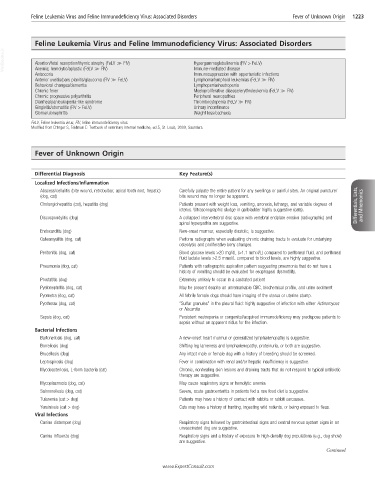Page 2466 - Cote clinical veterinary advisor dogs and cats 4th
P. 2466
Feline Leukemia Virus and Feline Immunodeficiency Virus: Associated Disorders Fever of Unknown Origin 1223
Feline Leukemia Virus and Feline Immunodeficiency Virus: Associated Disorders
VetBooks.ir Abortion/fetal resorption/thymic atrophy (FeLV ≫ FIV) Hypergammaglobulinemia (FIV > FeLV)
Anemia; hemolytic/aplastic (FeLV ≫ FIV)
Anisocoria Immune-mediated disease
Immunosuppression with opportunistic infections
Anterior uveitis/pars planitis/glaucoma (FIV ≫ FeLV) Lymphoma/lymphoid leukemias (FeLV ≫ FIV)
Behavioral changes/dementia Lymphopenia/neutropenia
Chronic fever Myeloproliferative disease/erythroleukemia (FeLV ≫ FIV)
Chronic progressive polyarthritis Peripheral neuropathies
Diarrhea/panleukopenia-like syndrome Thrombocytopenia (FeLV ≫ FIV)
Gingivitis/stomatitis (FIV > FeLV) Urinary incontinence
Glomerulonephritis Weight loss/cachexia
FeLV, Feline leukemia virus; FIV, feline immunodeficiency virus.
Modified from Ettinger S, Feldman E: Textbook of veterinary internal medicine, ed 5, St. Louis, 2000, Saunders.
Fever of Unknown Origin
Differential Diagnosis Key Feature(s)
Localized Infections/Inflammation
Abscess/cellulitis (bite wound, retrobulbar, apical tooth root, hepatic) Carefully palpate the entire patient for any swellings or painful sites. An original puncture/
(dog, cat) bite wound may no longer be apparent.
Cholangiohepatitis (cat), hepatitis (dog) Patients present with weight loss, vomiting, anorexia, lethargy, and variable degrees of Differentials, Lists, and Mnemonics
icterus. Ultrasonographic sludge in gallbladder highly suggestive (cats).
Discospondylitis (dog) A collapsed intervertebral disc space with vertebral endplate erosion (radiographic) and
spinal hyperpathia are suggestive.
Endocarditis (dog) New-onset murmur, especially diastolic, is suggestive.
Osteomyelitis (dog, cat) Perform radiographs when evaluating chronic draining tracts to evaluate for underlying
osteolysis and proliferative bony changes.
Peritonitis (dog, cat) Blood glucose levels >20 mg/dL (>1.1 mmol/L) compared to peritoneal fluid, and peritoneal
fluid lactate levels >2.5 mmol/L compared to blood levels, are highly suggestive.
Pneumonia (dog, cat) Patients with radiographic aspiration pattern suggesting pneumonia that do not have a
history of vomiting should be evaluated for esophageal dysmotility.
Prostatitis (dog) Extremely unlikely to occur in a castrated patient
Pyelonephritis (dog, cat) May be present despite an unremarkable CBC, biochemical profile, and urine sediment
Pyometra (dog, cat) All febrile female dogs should have imaging of the uterus or uterine stump.
Pyothorax (dog, cat) “Sulfur granules” in the pleural fluid: highly suggestive of infection with either Actinomyces
or Nocardia
Sepsis (dog, cat) Persistent neutropenia or congenital/acquired immunodeficiency may predispose patients to
sepsis without an apparent nidus for the infection.
Bacterial Infections
Bartonellosis (dog, cat) A new-onset heart murmur or generalized lymphadenopathy is suggestive.
Borreliosis (dog) Shifting leg lameness and lymphadenopathy, proteinuria, or both are suggestive.
Brucellosis (dog) Any intact male or female dog with a history of breeding should be screened.
Leptospirosis (dog) Fever in combination with renal and/or hepatic insufficiency is suggestive.
Mycobacteriosis, L-form bacteria (cat) Chronic, nonhealing skin lesions and draining tracts that do not respond to typical antibiotic
therapy are suggestive.
Mycoplasmosis (dog, cat) May cause respiratory signs or hemolytic anemia
Salmonellosis (dog, cat) Severe, acute gastroenteritis in patients fed a raw food diet is suggestive.
Tularemia (cat > dog) Patients may have a history of contact with rabbits or rabbit carcasses.
Yersiniosis (cat > dog) Cats may have a history of hunting, ingesting wild rodents, or being exposed to fleas.
Viral Infections
Canine distemper (dog) Respiratory signs followed by gastrointestinal signs and central nervous system signs in an
unvaccinated dog are suggestive.
Canine influenza (dog) Respiratory signs and a history of exposure to high-density dog populations (e.g., dog show)
are suggestive.
Continued
www.ExpertConsult.com

